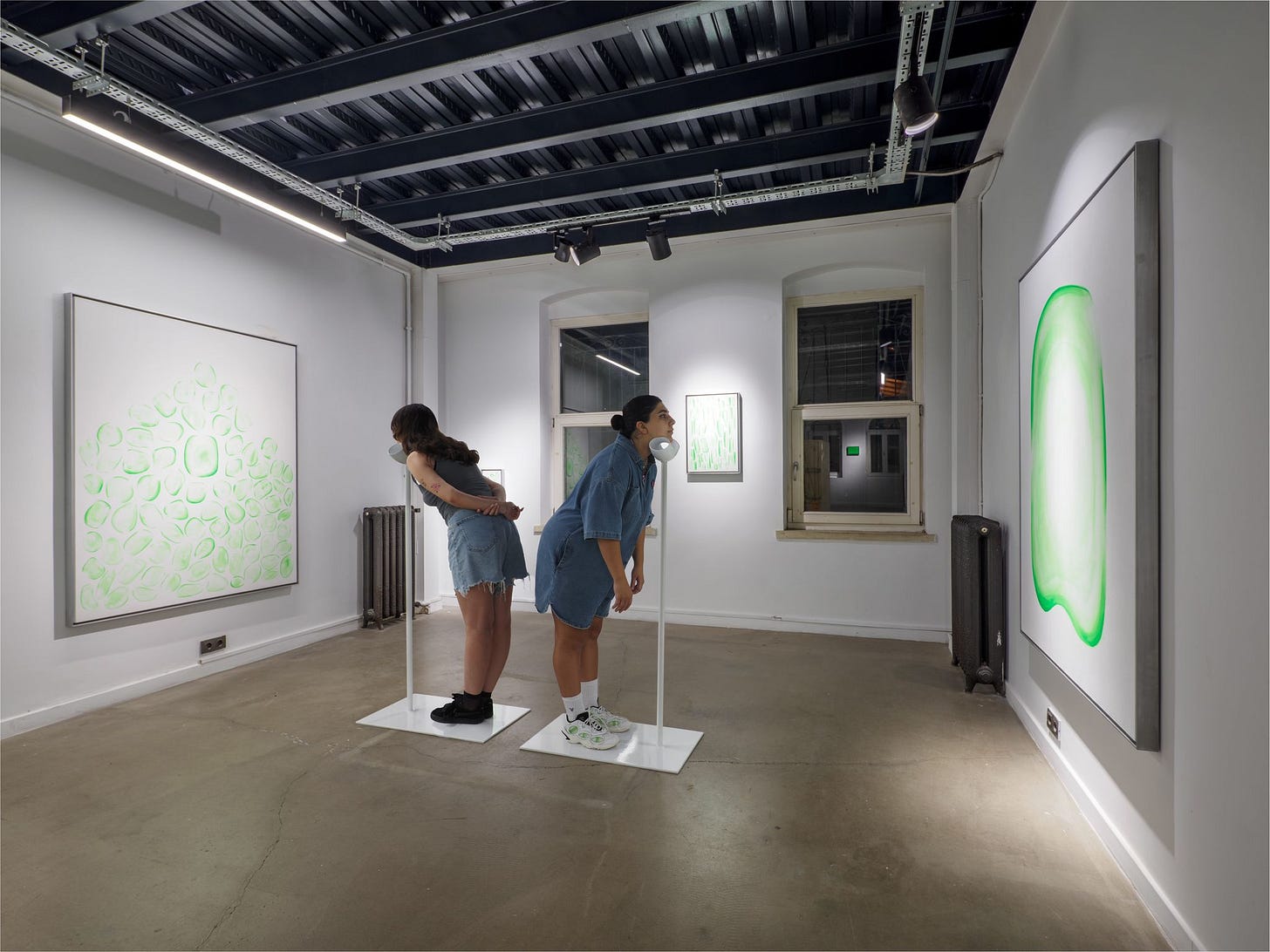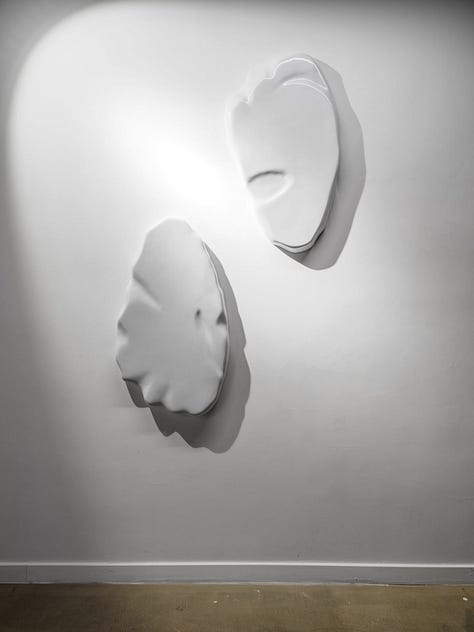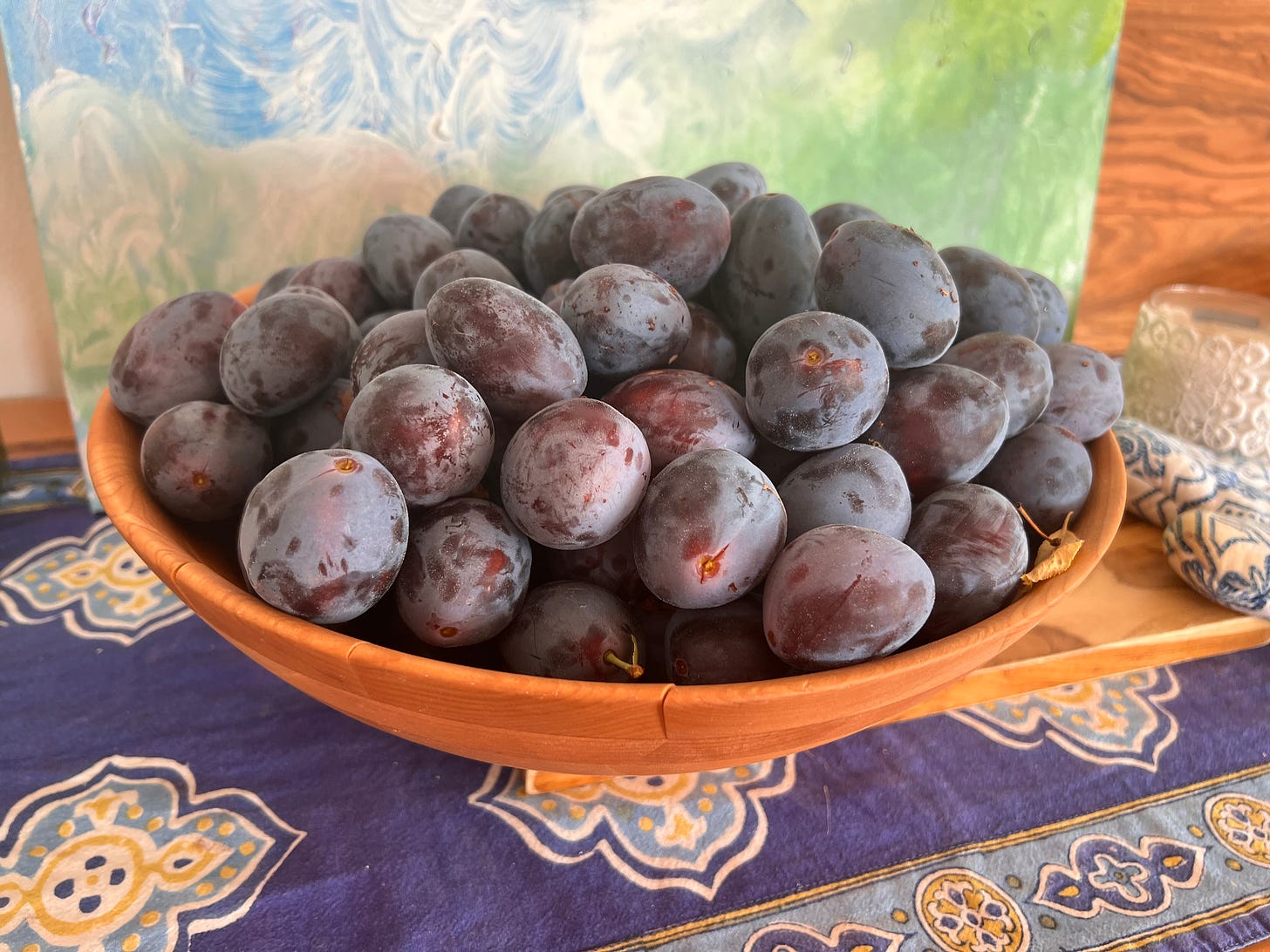There's something more to say about representation, but I fear it's illegible
Access, thinking, and touch; contemporary art & identity in Istanbul; Black writers, novels, and imagination; a graphic novel
Picture a white woman, middle age, with light brown hair tied back & black glasses. Her smile suggests enthusiasm and she’s wiping away the crumbs of a second slice of plum tart. An empty coffee cup is nearby.
Oh, you guessed it, that’s me! And you are reading a subjective version of alt text, or “alternative text,” written for an imaginary image (but thanks to my description, you’ve likely created one in your mind’s eye). Anyway, pretend you are using a screen reader—maybe you are!—alt text and the imaginary image is what you get every time you engage with a digital image. It’s a step up from blankness, or a file name, which is often what images render as for non-visual readers.
With decorative images (see the plums below, which are an attempt at a decorative image), stating blankness is redundant and annoying at best. But blankness is problematic when the image provides valuable information, meaning, or context to text and the non-visual user cannot access that context.
Writing alt text, or descriptive link commands, called aria labels, or closed captions, are a way to touch the mind’s eye. To transform something, to reach. And it’s work that takes skill and collaboration with the people who are using the tools. The slogan, “nothing about us, without us” is a catchy way to remember the politics involved in design decisions. There’s nothing straightforward about "representation” or “re-presentation” of information because every touch is a little different.
I was thinking about alt text today because it’s the 50th anniversary of Section 504 of the Rehabilitation Act. In 1973 in the United States—nearly two decades before the Americans with Disabilities Act—Section 504 mandated civil rights protections for people with disabilities in programs and activities that use federal money, such as public education. Effects of this legislation—which took additional sit-ins and protests for some enforcement—are that educational institutions with federal funding have had 50 years to facilitate access for disabled people. Though web development happened in tandem with these efforts, they were not always in conversation.
Access is a process, not a product. The work of facilitating access can be, at best, reflexive; it’s also labor. It can be poorly paid. Exploited. It’s care work that entails human interdependencies and a generative imagination about the embodied process of meaning-making.
One of my favorite ways of understanding access is by decentering the idea that thinking only happens in the brain as a “processing” of the external world. Rather, thinking is done through touch. And the tools, and mediums, we think through shape our worlds.
In a video below, scholar and activist Louise Hickman gives us a sense of what this means by describing the embodied experience of a person who gets around using a cane, based on work by Gregory Bateson, also known as Margaret Mead’s husband (this clause about his biography is inserted with a winky face). Hickman credits Bateson’s work for helping us understand how people using a cane “see” and ultimately “think” through their cane, their mind is at the very tip of it. Rough ground and grip are also involved.
Weeks ago, I started a section of the newsletter with tips on cultivating imagination. Of course, what a fraught and fascinating topic. Imagination. My tip today begins with the idea that touch is the beginning of thinking. That we’re touching when we’re making meaning. And this shifts what could be, and is, fraught about imagination and representation and thinking, and reorients us to radical possibilities.
7. Consider how the touch of the world touches you, subconsciously, implicitly, and bodily, and structures the way you think and your imaginaries. For example, implicit ideas about bodies structure and permeate design, as Hickman describes above, shaping—or causing friction and torquing—with our living.
(Links to the other entries on the list I started on how to cultivate imagination, read 1. 2, 3, 4, 5, 6. One of these days, I’ll put them all together.)
I was reminded of the challenges of reorientation because of the tyranny of form, language, and commercial values when I revisited a moving, forceful essay by New York Times writer Ismail Muhammad, “Can Black Literature Escape the Representation Trap?” which discusses how Blackness has functioned in the white imaginary as symbols or tropes, and difficulties of this “trap” or “choke” for Black novelists.
While the “trap” or “choke” (he’s quoting Toni Morrison) isn’t a new issue, he writes that Black writers and editors today face a distinct set of challenges because the publishing industry is hungry to sell legible or authentic (to white readers, or an imagined white reader) representations of diversity. Consequently, Black authenticity—and this is my half-hearted attempt to find a word that I think is often used, though it falls short—is painfully difficult to achieve because, constantly, tiredly, writers and editors are trying to find their way in this house of mirrors, when at every corner, there’s the imaginary white reader, a tricky overlord, explaining the most sentimental stories sell best.
The essay describes books and stories I haven’t read yet; I’m putting Zakiya Dalila Harris’s “The Other Black Girl” on my list. Muhammad suggests Harris’s novel is “successful” in criticizing the market demand for and institutional failures of diversity. But, these critiques also helped make the book a success. Talk about a double edge! In this way, he remarks, even the most gripping authenticity doesn’t escape the double consciousness “that white supremacy” demands on the Black writer’s psyche, it just names it for us.
Words about a double edge reminded me of my essay “Who is afraid of the art police” which I discussed in conversation with the novel Yellowface, by R. F. Kuang. Who gets to speak and how imagination is entangled with the specter of whiteness in narrative imagination and market—it’s a lot.
Representation is often described as a mirror. A re-presentation. But when we think of thinking as not a mirror, not as the mind processing the outside world, but a touch. Where could we go?
There’s something more I want to say about representation.
I wrote out what I thought was a suggestion for casting spells against representation, and commercialism, but I fear it is illegible.
—
Speaking of the perils of representation for the imagination, earlier this month, I had the privilege of editing, and contributing to, an exhibition catalog in English for contemporary artist Özge Çokgezen, who helps us think with color and form. (There are great words, though, too. I’ll share some below.) The catalog, Synthetic Identity, published by Ambidexter Gallery, accompanies the exhibition of the same name.
Their work, for me, invites us to imagine ourselves using the very qualities of materiality, such as color, weight, stroke, and form.
One of my favorite pieces is Çokgezen’s sculpture of mütteka, which are sticks to guide vision.

In their words:
“Mütteka is about human connections. This idea surfaced at a house in Beyazıt. I saw these sticks about ten years ago at a Mevlevi lodge which uses the original version, an ancient form. The result is a piece that uses sticks, which connects me and my own history and also allows you to set foot in the places where I have been.
Use the sticks for various forms of positions. Lean on them. Put your head on them. Reconsider an idea or keep thinking about the same thing until you realize what the concept actually is. They're like friends asking the right questions that make you feel. Beautiful language is the beginning of beautiful communication. They direct you to look into the eyes of the other person, or you just keep seeing the same thing until you realize it. You can feel the intensity of the connection by being in the moment or when you rest your chin or forehead against the metal bar. Relax into the pose for reflection.
We all have to spiritually navigate our paths and journeys alone because no one can support our dreams. Your journey requires a personal plan and effort from start to finish. As soon as people realize themselves, they become happy and bring peace to their surroundings. Despite all the external factors that distract attention, we must not stop seeing ourselves. This might be the simplest way to love each other.”
—
With Çokgezen’s permission, I’m excerpting my catalog essay “Infidelities,” along with more photos by Barış Özçetin.









Infidelities
Monika Sengul-Jones
Synthetic, as a word, has 400-year-old roots in both Greek and Latin and means “to bring together parts.” But most of us use the term to convey more recent meanings, including an 1874 reference to bring together products or materials made artificially by chemical synthesis. Then, since 1930, synthetic has come to simply mean "artificial."
To prefix “identity” with “synthetic” suggests the condition of being a person is partially, if not wholly, artificial. It’s a diagnosis that may resonate in a historical moment when personalities and relationships are experienced through corporate configurations of silicon and pixels. Performances of self in digital realms are ongoing co-curations of self-conscious choices, cultural norms, and governing algorithms. Artificial conditions also involve flesh and blood. We feed ourselves with genetically engineered food. We drink microplastics. We inject our veins with hormones and wear purified botulinum toxins. And, in times of crisis, we keep our hearts beating with tiny, battery-powered machines threaded above our aortas. Artificiality is inescapable.
Yet artificiality is also commonly understood as an unnaturalness—or a kind of hoax or sham. This turns synthetic identity into a paradox. On the one hand, synthetic means fraudulent. On the other, the conditions of personhood are synthetic. Consider how difficult it is to achieve wholeness if you are caught between these frames of reference.
In times of paradox, it's worth challenging the premise from which the contradictions arise. Identity, for so long, has been a lightning rod for division. Are you this, or are you that? Whose side are you on? Rather than looking for a pure source, begin inside the mess. Consider extending classical conceptualizations of identity, which often begin from sociological categories of class, ethnicity, nationality, or sex. There's freedom, joy, in bucking strict definitions of natural versus human-made. Just as word meanings shift over time, unfaithful to their origins, infidel conceptualizations for identity may also be inescapable.
—
The catalog also features essays from Emre Barca, Daniel Sabio, and Ulaş Parkan, by Ambidexter Gallery, it’s available for purchase and accompanies the exhibition; the works are also available for purchase. Should you be in Istanbul this month, or know someone who is, go! It is open through October 15, 2023.
Book recommendation
When Stars Are Scattered
by Victoria Jamieson and Omar Mohamed

My daughter brought home When Stars Are Scattered, explaining it was a page-turner. And it’s true, I couldn’t put it down. I was engrossed in the semi-autobiographical story for middle-grade readers of Omar and his brother, Hassan, children from a farm in Somalia who fled to Dadaab, a refugee camp in Kenya, during the (still ongoing) war in Somalia.
“For me, the first years are lost,” begins Omar. The story dilates the middle of their fifteen years waiting at Dadaab, a camp he notes in the afterward is called an “open prison” because refugees are not allowed to leave. It’s an experience of playing in the mud with his brother, “hunger days,” unfamiliar neighborhoods, the relatable anxiety of talking to adults in nice clothes, the stress of school exams, mean kids, fun kids, best friends, soccer, and so much waiting.
I did notice the “representation trap” is hard at work in humanitarian aid narratives. In the book, who has the worst story pits refugees against each other, there’s pressure to tell the story of your worst days the right way in order to be deemed worthy of resettlement, and this trap affects how refugees remember their lives. These disturbing effects are given careful treatment in this book.
At the core, though, the book is about spirals of longing and care. Omar and Hassan are always looking for their mother, from whom they were torn apart. Omar remembers just being held by Fatuma, his foster mother, without punishment or shame, when he cries and kicks and screams for his mother, for the indignities, for the unfairnesses. He longs for a different life for his schoolmates, there’s the outraged—loving way he relates to his classmate Maryam, and the unnamed girls like her. Though she’s curious and deserving—like every child is—Maryam is not able to finish school. And he cares for and is annoyed by and loves Hassan, his brother, who has an unnamed disability. Indeed, Hassan is beloved by Omar and Fatuma, and he’s a helper, and Fatuma nicknames him “my heart,” the shape of his face. Oh, my heart, we are touched. ♥
Thank you for reading The Gift.
Until next time,
Monika
The Gift



